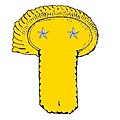This article needs additional citations for verification .(September 2024) |
This article lists the military ranks and the rank insignia used in the French Imperial Army. Officers and the most senior non-commissioned rank had rank insignia in the form of epaulettes, sergeants and corporals in the form of stripes or chevrons on the sleeves.


















